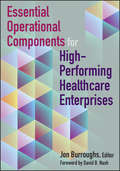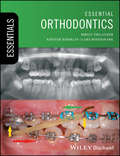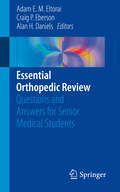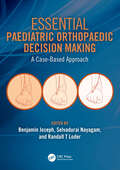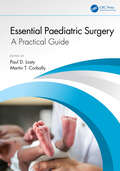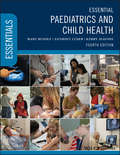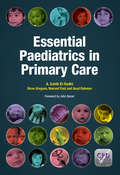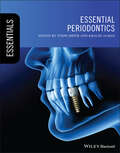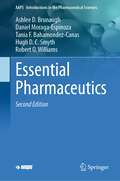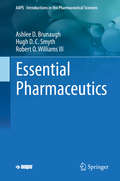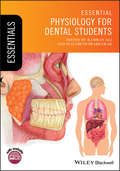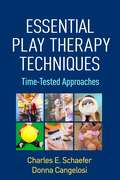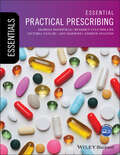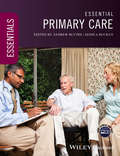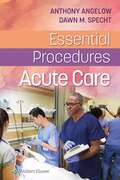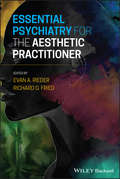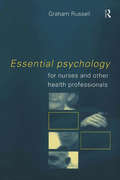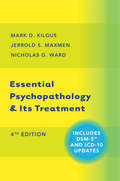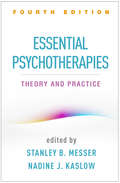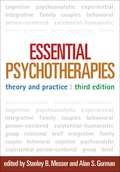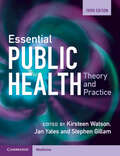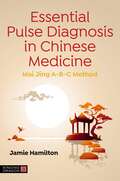- Table View
- List View
Essential Operational Components for High-Performing Healthcare Enterprises (ACHE Management)
by Jonathan BurroughsThe future of healthcare is clear. The move toward value-based care is happening at an unprecedented rate and requires healthcare enterprises to build delivery models that focus on clinical and business outcomes, not on volume. This shift requires a new infrastructure that supports the digitization, standardization, commoditization, and globalization of the healthcare industry. In Essential Operational Components for High-Performing Healthcare Enterprises, Jon Burroughs and other nationally respected experts highlight the operational building blocks necessary to engage, align, and transform healthcare organizations into integrated delivery systems capable of delivering population healthcare outcomes in new ways. They must marshal cutting-edge tools, including cloud-based data storage, disruptive innovation technologies, and strategic partnerships that span the globe. This forward-thinking book defines the fundamental operational components for achieving success in a value-based world, including: Collaborative leadership skills Governance competencies Rapidly evolving clinical and executive roles Dynamic strategic planning and contracting Models of clinical integration and alignment that are capable of managing actuarial risk Seamless transmission of cloud-based health information through global health information exchanges Predictive business and clinical analytics to manage actuarial risk and population healthcare outcomes A population health infrastructure to support the cost-effective redistribution of resources Other industries have undergone a similar transformation; now healthcare, the most complex industry of all, must complete these changes to excel in the new global marketplace. This book shows the way.
Essential Orthodontics
by Birgit Thilander Krister Bjerklin Lars BondemarkEssential Orthodontics is a comprehensive introduction to the biological principles of orthodontics. This book covers the why, when and how of orthodontics, enabling readers to identify which individuals need to be treated, to diagnose based on individual dentofacial development, and to understand the mechanical principles and tissue responses involved. Divided into three parts, this authoritative resource covers pretreatment considerations, treatment principles of skeletal and dentoalveolar anomalies, and tissue response to orthodontic and orthopaedic forces. Classification of malocclusions and craniofacial growth and development are discussed, and the text explores how to distinguish between normal occlusion and malocclusions. Essential Orthodontics outlines how to perform a comprehensive orthodontic examination leading to an orthodontic diagnosis, and the formation of a treatment plan. Following a student-friendly layout with key objectives and chapter summaries, Essential Orthodontics is an accessible yet comprehensive resource for both undergraduate and postgraduate dental students.
Essential Orthopedic Review: Questions and Answers for Senior Medical Students
by Craig P. Eberson Alan H. Daniels Adam E. EltoraiUtilizing a rapid-fire, two-column question and answer format, this is an ideal on-the-spot resource for senior medical students covering a wide range of both general and subspecialty orthopedic topics: anatomy, physiology, presentation and history, pathophysiology, differential diagnosis, physical examination, radiological evaluation, operative and non-operative treatment techniques, surgical complications, rehabilitation and more. With hundreds of high-yield questions and answer items, this quick reference covers orthopedic basics before moving on to detailed sections on the upper and lower extremity, axial skeleton, pediatric orthopedics, and systemic conditions. The straightforward Q&A format allows for either self-testing or quizzing with partners, whether practicing for a board review or studying up in one's spare time. While it can be read cover to cover for a general foundation of knowledge, it can also be referred to selectively before starting a new rotation or seeing a patient with a subspecialty attending. Useful as a companion text to Orthopedic Surgery Clerkship and Orthopedic Surgery Rotation, Essential Orthopedic Review is a handy, pocket-sized resource and review guide that can be used by senior medical students, nursing and PT students, primary care providers, and junior residents in orthopedics and sports medicine.
Essential Paediatric Orthopaedic Decision Making: A Case-Based Approach
by Benjamin Joseph Selvadurai Nayagam Randall T Loder Anjali Benjamin DanielThis collection of practical Case reports provides a concise guide to managing a wide spectrum of orthopaedic conditions in children. Strategies for determining an optimum management approach to follow in any given situation are provided, and are supported with clinical illustrations and guidelines. Sixty challenging clinical scenarios are presented, from malunion of a tibial fracture to pseudarthrosis of the tibia, after failed primary surgery. Each case is approached in a systematic manner with a background history, key features of physical examination and a series of questions.The questions lead to the goals of surgery, followed by a list of options for the management of each case. The option chosen by the surgeon is then presented, usually with intraoperative, clinical and radiographic illustrations. The majority of cases have substantial follow-up to illustrate the wisdom of the surgical decision-making, the surgical skill employed and the diligent post-operative care and follow-up. Trainees in pediatric orthopaedics and those sitting their final specialty examination will find this Case-based approach helps to anchor both their understanding and retention of key concepts.
Essential Paediatric Surgery: A Practical Guide
by Paul D. Losty Martin T. CorballyWith this timely practical textbook encompassing the full range of clinical conditions within paediatric surgery, surgeons-in-training will be delighted to discover that the book offers them a concise outline of paediatric surgical practice, thus ensuring that they are wholly familiar with a wide range of clinical scenarios.Key topics are included within sections on neonatal surgical conditions, surgical disorders of infancy, surgical conditions in childhood and adolescence, head and neck, hepatobiliary and pancreatic disorders, preparation of the child for surgery, malignant disorders, urology, neurosurgery and trauma. Short chapters complemented by clinical photography, schematic figures and tables splendidly enable the reader to understand key concepts with confidence.Author-experts throughout the world have generously contributed to this textbook, ensuring that the contents reflect ‘real world’ practice. A wide range of readers, notably surgeons-in-training, members of the paediatric surgery care team including nursing staff, postgraduates seeking core knowledge of paediatric surgery for board examinations, and surgeons planning to specialise in paediatric surgery, will benefit greatly from this practical guide.
Essential Paediatrics and Child Health (Essentials)
by Mary Rudolf Anthony Luder Kerry JeavonsEssential Paediatrics and Child Health is a comprehensive and practical guide to paediatric disorders as they present to the student and practitioner, offering step-by-step guidance on symptom assessment, history taking, physical examination, investigation and diagnosis, management and treatment, patient education, follow-up and prognosis. With full-colour images and a range of unique and innovative learning features, this completely revised new edition of the award-winning book Paediatrics and Child Health will prove an invaluable resource for medical students and junior doctors on their journey through contemporary paediatrics. Organises paediatric disorders into system-based chapters for easy navigation, with symptom-based and integrative discussions of all the important diseases and disabilities in paediatrics Combines up-to-date descriptions of the latest in basic and clinical science with the core competencies expected of students in paediatric rotations Self-directed learning is made easy by means of navigation diagrams, tables, key-point and "at-a-glance" boxes, links to guidelines and other summary aids Sections on student experience, self-assessment, doing well in paediatric clinical placements and preparing for examinations and OSCEs Includes a completely new introduction with perspectives on the nature of paediatrics and how best to become engaged and immersed within it, and new content on communication, national guidelines, imaging techniques, genetics and epigenetics, prescribing for children toxicology, the latest advances in diagnosing and treating disease, and much more Provides a companion website containing physical examination instruction videos, a complete set of interactive patient scenarios and multiple-choice questions Essential Paediatrics and Child Health is the ideal companion for medical students and junior doctors to succeed in their studies and clinical practice.
Essential Paediatrics in Primary Care
by A. Sahib El-Rahdi Steve Gregson Paul Navreet Asad Rahman'Anyone practising generalist paediatrics should have the material within these chapters either hard-wired in, or at the fingertips. This book is ideal for the primary care bookshelf...The authors have ensured that clinicians' paediatric knowledge and skills can only grow with familiarity of their material.' From the Foreword by John Spicer Essential Paediatrics in Primary Care covers the entire breadth of paediatric practice. Written by a team with frontline experience of the challenges and dilemmas faced in diagnosing and treating children in primary care, this practical text contains clear, evidence-based guidance about managing children in primary care and considers when referral to hospital is appropriate. The concise, list-based format enables a rapid, confident and knowledgeable diagnosis to be reached in the short time available in general practice. This reference book is invaluable for General Practitioners and GP trainees wanting to keep abreast of recent progress in paediatric care, but is also ideal for nurse practitioners, health visitors, medical students and paediatricians considering a career in general practice.
Essential Pain Pharmacology: The Prescriber's Guide
by Marco Pappagallo Howard S. SmithEssential Pain Pharmacology: The Prescriber's Guide expertly reviews the most important medications used to relieve pain, now considered by many physicians as the fifth vital sign. The catalogue of analgesics has expanded rapidly, and this text presents the most up-to-date, comprehensive array of agents available for prescribing. Each clear and concise drug entry covers the range of indications, advantages and disadvantages, and tips for appropriate dosing and avoiding adverse effects. A separate section covers nutraceuticals, a class of drug increasingly used to manage chronic pain, yet little discussed in medical literature. The detailed description of each medication enables the user to make quick and informed decisions, confident that they are best serving the needs of their patients. Practical 'pearls' for each entry provide a quick go-to reference for the key information to consider before prescribing. This concise user-friendly reference is a must-have on the shelf of every physician.
Essential Periodontics (Essentials (Dentistry))
by Khalid Almas Steph SmithESSENTIAL PERIODONTICS The Dentistry Essentials are an international series of textbooks, designed to support lecture series or themes on core topics within dentistry. A comprehensive yet accessible reference text designed for dental students and healthcare professionals alike Essential Periodontics provides rapid reference to key information about periodontal pathology, examination and diagnosis, treatment planning of common diseases, dental implantology, clinical decision making, and more. Contributions from experienced practitioners cover all the fundamental topics encountered in both periodontic training and practice, such as the anatomy and histology of the periodontium, basic principles of periodontal health, surgical therapies and suturing techniques, interdisciplinary periodontics, and management of periodontal emergencies. Each easy-to-read chapter includes a concise introduction, clearly defined learning objectives, a reference list of relevant scientific publications, tables and figures, and high-quality illustrations and clinical images. Aligns with the Classification of Periodontal and Peri-Implant Diseases and Conditions issued by the American Academy of Periodontology (AAP) 2018 World Workshop Follows a flexible modular format which can be easily integrated into any dental school’s teaching curriculum Discusses future advances and research in periodontics Includes several useful appendices, references to internet resources, and an extensive index Reflecting current practice and up-to-date scientific evidence, Essential Periodontics is a valuable resource for undergraduate dental students and healthcare professionals including dental hygienists, dental therapists, and general dentistry practitioners, which also includes interdisciplinary interests.
Essential Pharmaceutics (AAPS Introductions in the Pharmaceutical Sciences #12)
by Robert O. Williams Ashlee D. Brunaugh Hugh D. Smyth Daniel Moraga-Espinoza Tania F. Bahamondez-CanasParticularly in healthcare fields, there is a growing movement away from traditional lecture style courses towards active learning and team-based activities to improve retention of concepts and build higher level thinking through the application of complex problems with a strong foundation of facts and data. Essential Pharmaceutics is suited to this modern teaching style and is the first book of its kind of provide the resources and skills needed for the successful implementation of an active learning basic pharmaceutics course. This text offers a format that is specifically suited for integration in an active learning, team-based classroom setting. It is ideal for self-learning for the beginning pharmaceutics student, based upon the extensive utilization of figures, tables, and its overview of essential topics in pharmaceutics. Essential Pharmaceutics provides the requisite foundational knowledge for the development and implementation of case studies based upon modern drug products.
Essential Pharmaceutics (AAPS Introductions in the Pharmaceutical Sciences)
by Robert O. Williams III Ashlee D. Brunaugh Hugh D. SmythParticularly in healthcare fields, there is growing movement away from traditional lecture style course towards active learning and team-based activities to improve learning and build higher level thinking through application of complex problems with a strong foundation of facts and data. Essential Pharmaceutics is suited to this modern teaching style, and is the first book of its kind to provide the resources and skills needed for successful implementation of an active learning pharmaceutics course.This text offers a format that is specifically suited for integration in an active learning, team-based classroom setting. It is ideal for self-learning for the beginning pharmaceutics student, based upon the extensive utilization of figures, tables, and its overview of essential topics in pharmaceutics. Also unique to this text is the integration of case studies based upon modern pharmaceutical products which are designed to reinforce importance pharmaceutical concepts and teach essential skills in literature review and patent searching. Case studies covering all topics covered in the text have been developed by the authors that allow application of the content in the flipped-classroom pharmaceutical course.
Essential Physiology for Dental Students (Essentials (Dentistry))
by Kamran Ali Elizabeth PrabhakarEssential Physiology for Dental Students offers comprehensive information on human physiology, tailored to the needs of students of dentistry. This new addition to the Dentistry Essentials series helps students gain a deeper understanding of how physiological concepts apply to clinical dental practice. Each chapter outlines an organ system in sufficient detail whilst emphasizing its relevance to clinical dentistry. Written in a student-friendly style, it contextualizes how normal and altered physiology affects dental care and highlights the implications of dental interventions on the body’s functioning. Essential Physiology for Dental Students provides readers with complete coverage of: cell physiology; nerve and muscle physiology; the cardiovascular system; the respiratory system; the gastro-intestinal system; the renal system; haematology; endocrinology including the regulation of blood glucose and blood calcium; and the central nervous system. Covers each system in detail, while emphasizing the relevance to dental students Presented using a reader-friendly layout with illustrations and clinical photographs throughout Features interactive MCQs and EMQs and downloadable images on a companion website Essential Physiology for Dental Students is an excellent resource for undergraduate dentistry students, dental hygiene and therapy students, and dental nursing students. It also greatly benefits newly qualified dentists preparing for postgraduate examinations such as MFDS, LDS, ORE, and also the US National Boards.
Essential Play Therapy Techniques
by Charles E. Schaefer Donna CangelosiHighly practical and user friendly, this book presents 58 play therapy techniques that belong in every child clinician's toolbox. The expert authors draw from multiple theoretical orientations to showcase powerful, well-established approaches applicable to a broad range of childhood problems. Activities, needed materials, and variations of each technique are succinctly described. Of critical importance for today's evidence-based practitioner, each chapter also includes a historical perspective on the technique at hand, a rationale explaining its therapeutic power, and a review of relevant empirical findings. The book enables readers to determine which strategies are appropriate for a particular child or group and rapidly incorporate them into practice.
Essential Practical Prescribing
by Andrew Stanton Victoria Taylor Amy Hawkins Benedict Lyle Phillips Georgia WoodfieldEssential Practical Prescribing is an important new textbook with a clinical, ward-based focus. It is specifically designed to help new foundation doctors working on the hospital wards and in the community, as well as medical students preparing for the Prescribing Safety Assessment.Using an accessible format, Essential Practical Prescribing demonstrates how to manage common medical conditions, and explains the logic behind each decision. It also emphasises common pitfalls leading to drug errors, and highlights drugs that could cause harm in certain situations. Organised by hospital department, it outlines the correct management of conditions, as well as highlighting the typical trials of a junior doctor.Essential Practical Prescribing:* Contains a range of learning methods within each chapter including: key topics, learning objectives, case studies, DRUGS checklists, 'Top-Tips', advice on guidelines and evidence, and key learning points* Uses patient histories to set the scene and enhance the clinical emphasis* Offers examples of correctly completed drug charts throughout, which are also available online* Is an ideal companion for Prescribing Safety Assessment (PSA) preparation * Includes a companion website at www.wileyessential.com/prescribing featuring MCQs and downloadable DRUGS checklists and drug charts
Essential Primary Care
by Andrew Blythe Jessica BuchanEssential Primary Care aims to provide undergraduate students with a comprehensive overview of the clinical problems encountered in primary care. It covers the structure of primary care in the UK, disease prevention and the management of common and important clinical presentations from infancy to old age. Case studies are used in every chapter to illustrate key learning points. The book provides practical advice on how to consult with patients, make sense of their symptoms, explain things to them, and manage their problems.Essential Primary Care: * Is structured in five sections: - The building blocks of primary care: its structure and connection with secondary care, the consultation, the process of making a diagnosis, prescribing, and ethical issues - Health promotion - Common and important presenting problems in roughly chronological order - Cancer - Death and palliative care* Gives advice on how to phrase questions when consulting with patients and how to present information to patients* Provides advice on how management extends to prescribing - often missing from current textbooks* Contains case studies within each chapter which reflect the variety of primary care and provide top tips and advice for consulting with patients* Supported by a companion website at www.wileyessential.com/primarycare featuring MCQs, EMQs, cases and OSCE checklists
Essential Procedures: Acute Care
by Anthony Angelow Dawn M SpechtStrengthen your advanced practice, acute care nursing skills with Essential Procedures: Acute Care, the indispensable tool for learning how to safely and confidently perform the most common acute care procedures. Organized by body systems, the procedures covered in this book include arterial line insertion, wound closure, and lumbar puncture. A handy, spiral-bound text that lies flat, this ideal resource offers step-by-step direction for acute care nursing students; it is also a handy on-the-unit reference for new acute care nurse practitioners.
Essential Psychiatry
by Robin M. Murray Kenneth S. Kendler Peter McGuffin Simon Wessely David J. Castle Robin M. Murray Kenneth S. Kendler Peter Mcguffin Simon WesselyThis is a major international textbook for psychiatrists and other professionals working in the field of mental healthcare. With contributions from opinion-leaders from around the globe, this book will appeal to those in training as well as experiences professionals seeking a comprehensive and up-to-date overview of effective clinical practice backed by research evidence. The book is divided into cohesive sections moving from coverage of the tools and skills of the trade, through descriptions of the major psychiatric disorders and on to consider special topics and issues surrounding service organization. The final important section provides a comprehensive review of treatments covering all of the major modalities. This new and completely revised edition is the only book to provide this depth and breadth of coverage in an accessible, yet authoritative manner.
Essential Psychiatry for the Aesthetic Practitioner
by Evan A. Rieder Richard FriedAesthetic practice requires an understanding of human psychology, yet professionals across cosmetic medicine and related fields receive no formal training in identifying and managing psychological conditions. Essential Psychiatry for the Aesthetic Practitioner provides concise yet comprehensive guidance on approaching patient assessment, identifying common psychiatric diseases, and managing challenging situations in cosmetic practice. This much-needed guide brings together contributions by dermatologists, plastic surgeons, psychiatrists, psychologists, and other experts to help practitioners understand the role of psychology in cosmetic practice and improve interpersonal relations with their patients. Assuming no previous background knowledge in psychiatry, the text provides cosmetic practitioners of all training and experience levels with clear guidance, real-world advice, and effective psychological tools to assist their practice. Through common clinical scenarios, readers learn to determine if a patient is a good candidate for a cosmetic procedure, enhance the patient experience, deal with difficult personalities in the cosmetic clinic, recognize obsessive compulsive and body dysmorphic disorders, and more. Describes how to use psychologically informed approaches and treatments for aesthetic patients Features easy-to-use psychological tools such as motivational interviewing, progressive muscle relaxation, guided imagery, and acceptance and commitment therapy Includes extensive references and practical tips for understanding the psychological implications of cosmetic treatments Covers cosmetic consultations for female, male, and transgender patients Discusses the history and psychology of beauty as well as the role of cosmetics and cosmeceuticals Emphasizes the importance of screening for common psychological comorbidities Addresses the impact of social media on self-image and its role in a growing crisis in beauty and appearance Highlights the need to develop new guidelines to treat rapidly evolving patient populations Explores how gender fluidity and variations in ethnicity are changing the approaches to aesthetic patients Essential Psychiatry for the Aesthetic Practitioner is required reading for dermatologists, plastic surgeons, cosmetic doctors, dentists, nurses, and physician assistants and all other professionals working in aesthetic medicine.
Essential Psychology for Nurses and Other Health Professionals
by Graham RussellThis text examines the concepts which are fundamental to everyday nursing practice. Understanding how individuals function psychologically in health and illness is vital to providing appropriate care for all patients and clients. Assuming no previous knowledge of the subject, the author explores the basis of individual psychology focusing on personality traits, beliefs systems, body-image and self-esteem. Periods of illness are seen as psychologically demanding events which individuals cope with in different ways. The book considers how we recognize and interpret the signs and symptoms of illness in ourselves, what influences the decision to seek help and whether or not we comply with advice from health professionals. The contribution of psychological factors to physical wellbeing is also examined and the link between psychological theory and patient care is examined throughout the book. With scenarios and questions to help the reader apply the concepts to nursing practice Essential Psychology for Nurses provides an excellent introduction to the subject for pre-registration students and those studying psychological concepts in relation to health care.
Essential Psychopathology & Its Treatment
by Mark D. Kilgus Jerrold S. Maxmen Nicholas G. WardLong considered a leading text on the assessment, diagnosis, and treatmentof psychiatric disorders, this latest revision includes cutting-edge updates inneuroscience, psychopharmacology, and genetics. Geared to resident students inpsychiatry and related disciplines, it makes practical, readable sense of the field.
Essential Psychotherapies, Fourth Edition: Theory and Practice
by Stanley B. Messer Nadine J. KaslowAcclaimed for its clear writing and stellar contributors, this authoritative text is now in a revised and updated fourth edition. The book explains the history, assessment approach, techniques, and research base of each of the 12 most important psychotherapies practiced today, along with its foundational ideas about personality and psychological health and dysfunction. The consistent chapter format facilitates comparison among the various approaches. Every chapter includes engaging clinical vignettes and an extended case example that bring key concepts to life, as well as suggested resources for further learning. New to This Edition *Incorporates important developments in clinical practice and research. *Entirely new chapters on CBT, third-wave CBT, couple therapies, and interpersonal and brief psychodynamic therapies; all other chapters fully updated. *Increased attention to multiple dimensions of diversity, the evidence-based practice movement, psychotherapy integration, and applications to physical health care.
Essential Psychotherapies, Third Edition
by Alan Gurman Stanley MesserThe leading survey text for basic psychotherapy courses, this book offers authoritative, engaging presentations of the 12 most important forms of psychotherapy practiced today. Prominent experts cover traditional treatments as well as influential models that have been developed relatively recently, giving students and practitioners a solid grasp of foundational theories, techniques, and research. Each chapter follows a common set of organizational guidelines; features illustrative vignettes and a full case example; and concludes with readings and resources to guide further study. New to This Edition *Incorporates the latest clinical developments and research. Chapter on "third-wave" behavior therapies. Each chapter has expanded discussions of the role of the therapeutic relationship and the use of evidence-based practices. Concise chapters make the book even more instructor and student friendly.
Essential Public Health
by Padmanabhan Badrinath Jan Yates Stephen GillamHow can society most effectively prevent disease and promote health? That is the challenge addressed by this textbook. Public health is the art and science of preventing disease, prolonging life and promoting health through the organised efforts of society. The 'science' is concerned with making a diagnosis of a population's health problems, establishing their cause and determining effective interventions. The 'art' lies in creatively addressing these problems. Essential Public Health captures both the art and science of the field. This second edition has been fully updated with contemporary examples and includes new chapters on sustainability and change, management and leadership. Examples are taken from health systems throughout the world, giving readers a wider perspective of the challenges faced. This is essential reading for all trainees in health care, social care and related disciplines. An internet companion includes supplementary information and interactive, self-assessment questions to test understanding and aid learning.
Essential Pulse Diagnosis in Chinese Medicine: Mai Jing A-B-C Method
by Jamie HamiltonPulse diagnosis is a notoriously complicated area in Chinese medicine with very few practical or accessible resources available to practitioners to improve their skillset. This clear, didactic manual provides detailed yet user-friendly instructions for a pulse diagnosis method the author has developed called Mai Jing A-B-C, allowing for clinical competency and confidence in pulse diagnosis.Jamie Hamilton draws on pulse methods and techniques found primarily in the 3rd century classic of Chinese medicine, Mai Jing, that have often been overlooked in later centuries. He uses his teaching background to reassess these methods and breaks down incredibly complex concepts into simpler forms to enable learning and immediate application into practice. The method has been honed into six simple steps, each accompanied by detailed case studies to further aid clarity.
